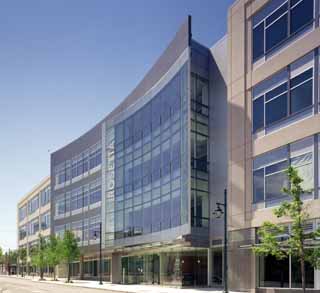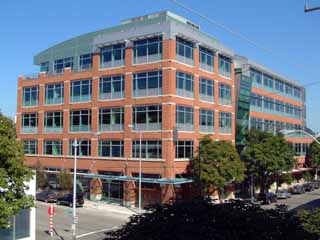
DJC.COM
March 3, 2005
Building a foundation for biotech
Special to the Journal

Image courtesy of Merck
The Rosetta Inpharmatics building is one of several new South Lake Union buildings for biotech companies. The developer had permits in hand when Rosetta expressed an interest in the area, enabling the pharmaceutical company to begin without delay.
|
Long an unassuming industrial area, Seattle's South Lake Union neighborhood is on the verge of reinventing itself. Available land and like-minded neighbors have made the area loosely bordered by Interstate 5, Highway 99, Denny Way and Lake Union an attractive place for biotech companies to locate.
A recent study by the Milken Institute names Seattle as the fifth largest biotech center in the nation, and a presentation last month by the city's Office of the Mayor to the Senate Labor, Commerce, Research and Development Committee estimates that more than 700 new jobs came to South Lake Union in 2004.
It's no coincidence life science firms are seeking out Seattle — and South Lake Union in particular — as a place to plant their roots. Anchored by the nearby University of Washington School of Medicine and the Fred Hutchinson Cancer Research Center, the area offers a ready-made home base for biotech firms, which tend to cluster to take advantage of the scientific discovery and information sharing that results from close interaction. The growing South Lake Union neighborhood is already home to Zymogenetics, Seattle Biomedical Research Institute, Rosetta Inpharmatics and an expansion of Children's Hospital Regional Medical Center, with a number of other biotech-related firms preparing to move in.
"While other parts of the country are chasing industry, we truly have a foundation here," said Jill Nischi, director of the city's Office of Economic Development, who heads up efforts to draw business to the Seattle area. "(The area's) ability to attract the best and the brightest is unparalleled."
Efforts of the city and the neighborhood's major property owners don't hurt, either. The city of Seattle and major South Lake Union-area developer Vulcan Inc. have each made substantial overtures to draw biotech firms to the neighborhood, both through far-reaching neighborhood revitalization efforts and industry-specific incentives.
Spreading the word
The Seattle City Council last year loosened building requirements to allow the South Lake Union area to better accommodate the needs of biotech firms. The code amendments lift restrictions on floor-to-ceiling heights, allowing more room for the robust infrastructure such companies require, and also allow for additional rooftop mechanical equipment. Parking requirements were also reduced, since the employee-space ratio is generally less than that in typical office buildings.
The city is also heavily involved in public relations efforts, touting the virtues of the South Lake Union neighborhood at conferences and workshops across the country. Seattle has been active at the annual Biotechnology Industry Organization international conferences, including last year's gathering in San Francisco that drew more than 16,000 registered attendees.
Vulcan, which owns 60 acres in South Lake Union, has also recognized the attractiveness of the area for biotech developers. The owner has hired an in-house project manager specializing in the design and construction of life science facilities, said Ada Healey, Vulcan's vice president of real estate.
Additionally, Vulcan's financial ability to pursue pre-development without a specific tenant in hand has helped attract biotech firms with a fast-track schedule. Children's Hospital, Rosetta Inpharmatics and SBRI all needed space quickly, Healey said, and since Vulcan already had plans and permits in hand, construction could start without delay.
"We sold them on the fact that we could meet their quick time frame," said Healey.
The University of Washington's School of Medicine is the neighborhood's newest tenant, occupying 105,000 square feet in the renovated Blue Flame Building, formerly occupied by Washington Natural Gas. The school's research efforts have grown in recent years, said Tina Mankowski, director of health sciences and the UW Medicine's news and community relations department, necessitating a move to expanded space. The move allows the school to consolidate biomedical research activities, with a focus on cardiovascular diseases and women's issues, in a new state-of-the-art facility. The school has plans to expand in the area in the future, Mankowski said.
Creating a neighborhood

Image courtesy of Vulcan Inc.
The five-story Seattle Biomedical Research Institute building is among 12 Vulcan projects in South Lake Union that are either under development, completed or planned for the near future. The projects total about 3 million square feet.
|
Wider efforts are being made at both the public and private levels to create an active neighborhood that extends beyond industrial use and office buildings. Vulcan's ventures encompass both commercial and residential uses, including the 2200 Westlake project which will offer 260 condominium units, a Pan Pacific Hotel and a Whole Foods supermarket when the development opens in August 2006. Vulcan is also building Alley24, a mixed-use residential and office development that will house Seattle architectural firm NBBJ and Seattle general contractor Skanska when it opens in April 2006.
Efforts to create a rounded neighborhood are deliberate, said Healey.
"You want to be able to offer scientists and researchers an attractive place to work," she said. "A company's most important asset is intellectual capital — it walks in the door in the morning and out the door at night."
The city is also pursuing a number of ventures that seek to improve the neighborhood as a whole and serve to attract people and business to South Lake Union.
Plans for a park at the former Navy Armory at the lake's southern tip are moving forward, with Pro-Parks Levy funds secured and private fund-raising efforts for $20 million more in full swing, said Michael Mann, deputy director of the city's Office of Policy and Management.
Plans are also in motion for a street car to link South Lake Union with other Seattle neighborhoods, and the City Council has indicated a strong desire to turn nearby Mercer Street into a more welcoming and easier-to-maneuver two-way thoroughfare.
The city estimates that by encouraging the prosperity and growth of biotech and other business in South Lake Union, 23,000 new jobs and 10,000 new units of housing can be developed over the next 15 years, said Mann. That translates into a significant financial gain for the region: an estimated $165 million to $330 million in increased tax revenue over the next 20 years.
"We think it's an investment that makes sense," said Mann, "not just for South Lake Union, but for the entire city."
Sheila Bacon is a freelance writer who covers the Northwest's architecture, engineering and construction communities.
Other Stories:
- Can Seattle become a first-tier biotech hub?
- Laptops, Treos and phones! (Oh my!)
- Form follows function, even for biotech
- Build it right and they will come
- New buildings bring science into the city
- How one local developer took the biotech plunge
- 6 myths about building for biotech
Copyright ©2009 Seattle Daily Journal and DJC.COM.
Comments? Questions? Contact us.